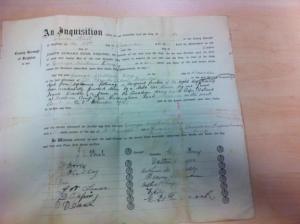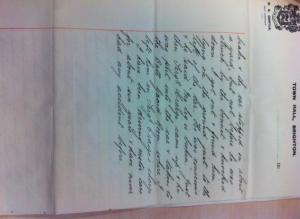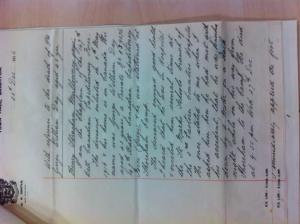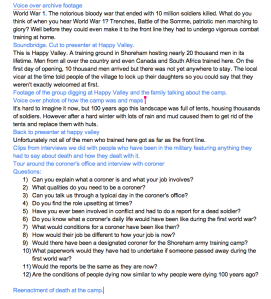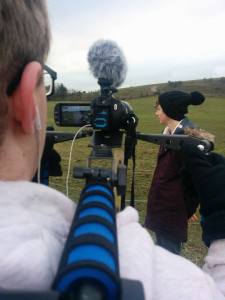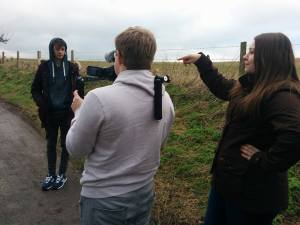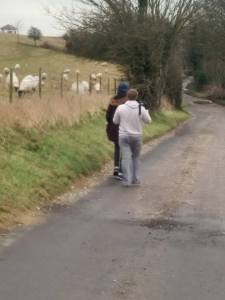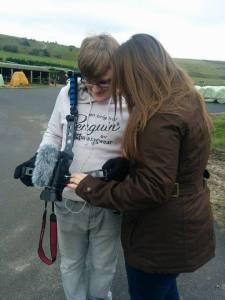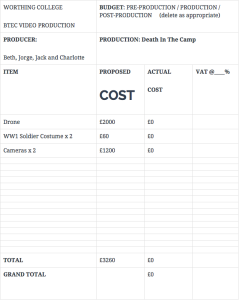I have taken inspiration from Dara Birnbaum’s ‘Technology/Transformation: Wonder Woman’ video and taken her use of repetition to be a prevalent event throughout the entire video. Dara Birnbaum used her repetition as a way to make audiences bored of seeing the same thing over and over again, saying that all superhero shows are much the same as that. I chose to use the same ideology for American commercials, after spending a number of holidays there I found that the commercials played there follow the same or at least a similar pattern, of which I have exploited with this use of repetition. Another meaning I have tried to make was through my use of playing it on a TV in a dark room. I find that despite how unnecessary these items that are being advertised seem to be, people will still watch the commercial and possibly buy it anyway. I want to get across the message that these items are unimportant and that despite the audience knowing this, they will watch anyway.
Unit 35: Second Edit
I took on board what my teacher said about keeping the editing pace short and instead of leaving the takes of each commercial to reach the end of the sentence, I cut them down so they were still relevant, but were much shorter than before. For example in the first edit I leave in the first shot of Anthony Sullivan holding up the ‘Sticky Buddy’ saying ‘it doesn’t matter’ but in this edit I remove that, it’s unnecessary.
In both edits, the idea of having the very ending scene with Anthony Sullivan saying ‘It doesn’t matter’ came from a friend of mine in the class. He originally said it as a joke but I saw it as a good idea because it reinforces the point of this video, the point being that these products are unnecessary and they don’t matter, yet people will crowd around to watch it anyway because they’re intrigued, despite the item being pointless.
Unit 35: First edit
Originally my idea was to be this, with the beginning to be really short and snappy yet cheesy at the same time with each commercial being used to show that they’re exactly the same. Except about halfway into the video, the editing starts to get less snappy and rather dull and long. My teacher noticed this and immediately noted that, suggesting ways to avoid that dullness such as ending it halfway through on the ridiculous ‘Pineapple Candle’. I knew what my teacher was saying but I didn’t want to end it without reaching the end of the commercials. However I agreed with what Jason said about trying to keep the editing short which is shown in my next post.
Unit 35: Introduction to Video Art Installation – Video Art Installation Artists
Unit 35 is all about video art installation, and testing whether we can create our own. Video art is a form of art which uses video and image in a fluid, intriguing way. Video art can vary depending on the artists. Some video art is a simple 5 second sample of audio with a video which is out of sync with the audio, or it can be a variety of colours which are projected on the side of a building. Some are seen in galleries such as the Tate Modern and some are broadcast on television for a few seconds. The meaning you take from video art can vary depending on what you have decided to watch. For example Nam June Paik relies on using digital and audiovisual effects to create different images on an old TV, some may see this as the artist saying that nothing lasts forever because of the use of digital effects or some may consider this to be a time capsule of sorts. It all depends on the art and whoever is looking at it.
Video art installation structure can change depending on who is making it, some may be shown in loops, which is something one of the artists I am researching for this essay does. While some others can be linear (or non-linear) narratives such as Matthew Barney’s ‘Cremaster Cycle’. Whether there is a message to send or if there’s a narrative behind the work depends on the artist.
After looking at a lot of video artists I have learned that many are experimental, using various colours and images (and sometimes people) to create different looks and meanings. However two artists which didn’t make their videos as colourful or non-linear stuck out to me as an inspiration for my work in Unit 35
Dara Birnbaum
Dara Birnbaum is an American video art installationist who started her works in the 1970’s challenging gender bias in an intriguing way. She uses the power of repetition and rhetoric to make the 1970’s TV show ‘Wonder Woman’ become dull and uninteresting.
The idea behind making ‘Technology/Transformation: Wonder Woman’ was that Dara found most Television shows to be structured in a similar way, what with an exciting beginning and use the same or similar tropes to each other. The use of repetition was to imply that audiences have seen this before in many other shows and they’re simply watching it on repeat with a different look. She also challenges gender bias in this video simply by using the repetition. She wanted to use the repetition to take away the sex appeal of the character and instead make the audience focus on the video. Dara picks out a lot of clips of the character spinning around in order to change into her uniform, using that as a message against how fixed gender roles set women as a sex object, regardless what character they play they exist to look good.
Other than the structure of the video and the idea behind it, she doesn’t really explore any micro or macro features of Wonder Woman, she simply just repeats every clip to send the messages.
I can apply a similar theme to my own video art installation, using the idea behind the repetition meaning that you are seeing the same thing time and time again just simply in different forms. Instead of just simply using one video though, I shall use multiple videos.
Unit 35: Idea during the lesson/Replacement for previous idea
My original idea was going to take a long time to film considering all the equipment and props that I would need. It was a very narrative video involving two men in suits and glasses (representing law and authority) kidnapping a stranger and forcing him to watch American commercials and American news programmes. The stranger keeps getting forced to fill out forms about it and call up the number the commercials are advertising. The idea of this was to advertise the fact that freedom is a lie and we’re being forced and conditioned to buy things we don’t necessarily need. However this felt a bit too narrative and as though I was kind of shoving it in your face rather than allowing the audience to see it for themselves.
The idea I had last week was similar, instead it was simply going to involve the camera panning into a TV screen in the corner of a dark room which will show static and then an American commercial. It’ll then cut to a stranger staring unblinkingly at the TV screen while a seemingly ‘holy’ light shines up his face. It’ll cut back to the screen which will flash with static again and change to another commercial. Every time it cuts back to the stranger he or she would look more tired and zombified. The final thing that shows on the screen is an American news programme and the stranger would look as though they’re sleeping with their eyes open.
This idea still seemed a little as though it was pushing the idea that commercialism is a form of control in your face. Realising this has led to my final idea for this.
My final idea for Unit 35 is very similar to the previous idea and it’s mostly the same. The TV is in the corner of a dark room showing various commercials and news programmes. Except the difference is there’s not going to be a stranger watching it. The ‘stranger’ is going to be the audience who watch it. This is because of the placement of where it’s going to be shown. It’s going to be shown on a TV in the same place as the TV that is being filmed and everyone who watches it prove the fact that commercialism is a form of control, because the audience will hopefully be watching it for the duration of the video.
Unit 27: Coroners Reports
Unit 27: Script of the Production
Unit 27: Happy Valley Trip
A member of our group – Beth – emailed Gail Mackintosh (Director of the project) about arranging a trip to Happy Valley. Gail in turn got in contact with the Keiths who own the farm to arrange it. Here are the emails that came of the arrangement. 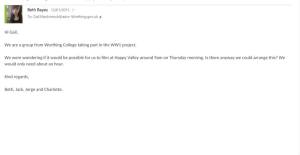





We went to Happy Valley on the Monday to film the introduction of our production. We chose Jorge to be the presenter and more information about that is detailed here (https://jackgilbertmedia.wordpress.com/2015/04/29/profile-of-our-presenter/ ). I was chosen to film while Charlotte and Beth co-directed.
While we were at the farm we managed to film everything we needed to, from the opening scene to the end. Jorge later went back with a friend of his to film the drone footage we used for parts of the production.
Here are the images taken during the filming of Death in the Camp.
Unit 27: Budget
Unit 27: Re-Enactment Script
1) INT. A STUDIO WITH BLACK BACKGROUND. WW1 SOLDIER SITTING ON A CHAIR BEING INTERVIEWED. YOU NEVER SEE THE INTERVIEWER ONLY THE SOLDIER.
INTERVIEWER
How did you know Joseph?
SOLDIER
Joe and I were both in the 10th reserve battalion of the Canadian Expeditionary. We were both stationed at Shoreham Camp together.
INTERVIEWER
What can you remember about the day he died?
SOLDIER
It started as just a normal day in the camp. It was a fairly dry, sunny typical day in May. In the morning Joe said he felt a bit ill and that if he wasn’t better by Sunday then he would go and see the medical officer. I just assumed he had a bit of a cold or something. At about 1:45 I was training on the firing point in the Rifle Range and he was in charge of the phone box. We were standing not too far away from each other. He came over to me and asked for a cigarette. I thought nothing of it and gave him one. Then shortly after he called me and asked me to come over. So I went over to him and he said he’d been sick. I told him to lay on the grass and I undone his clothes. Then he threw up again and complained that his head and chest were hurting.
INTERVIEWER
What did you do next?
SOLDIER
I informed the officer in charge of the range and he took over. 2) INT. SAME STUDIO BUT THIS TIME THE INTERVIEWEE IS THE OFFICER WHO WAS IN CHARGE
INTERVIEWER
Tell us what happened when you got to the scene.
OFFICER
I got to the scene and Joe was lying on the floor. It was a hot day so I assumed at first that he probably had sunstroke. However he was conscious and had been vomiting. I sent for a medical officer and one came. He examined the deceased and ordered his removal to a Hospital at once.
INTERVIEWER
And what happened after the ambulance arrived at the scene?
OFFICER
Joe was moved to the 2nd Eastern General Hospital in Dyke Road. I accompanied him. After waiting about 20 minutes he was taken to the St Marks Schools Branch Kemp Town but the deceased died before we arrived there.
INTERVIEWER
I realize this must be hard for you so thank you.
